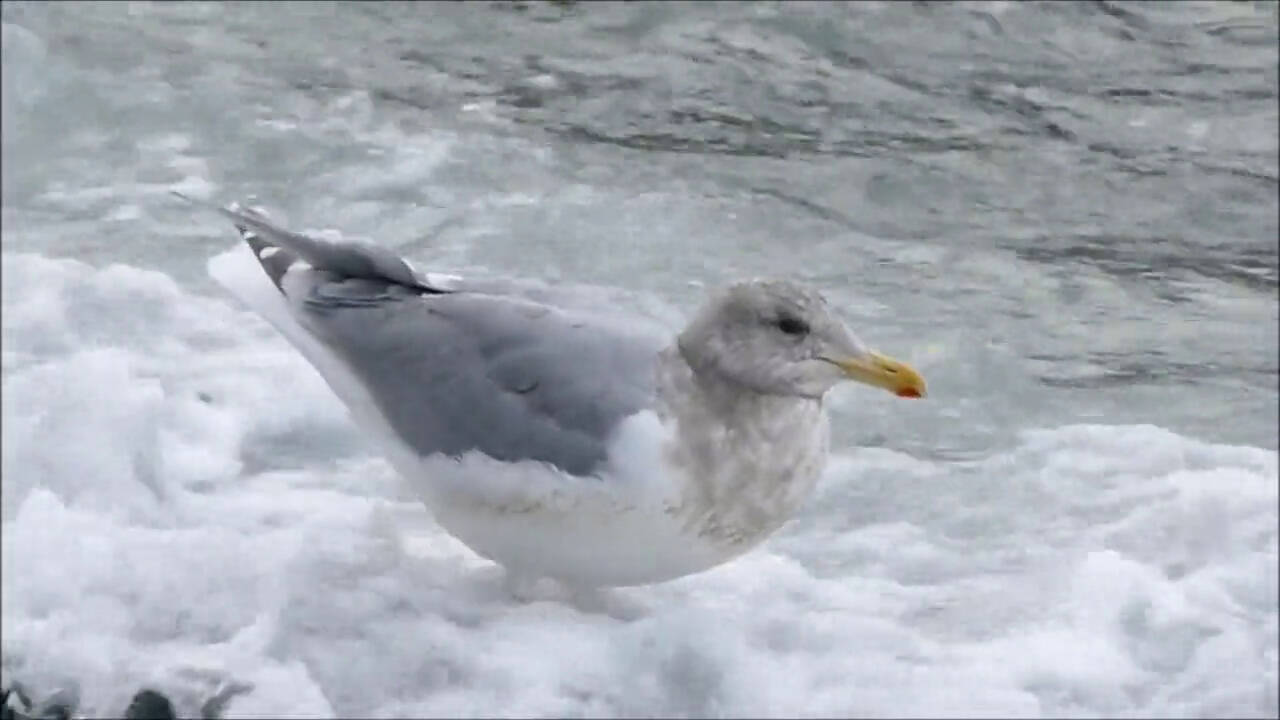By Mary F. Willson
Surf’s up!
In early January, high winds stirred the waters of Juneau, making boating an unpleasant if not downright dangerous proposition. The waves pounded the coastlines, roiling the waters next to the shores. Even moderate wave action at the shoreline is sometimes a good thing for hungry birds—the turbulence seems to wash out small invertebrates into open water where ducks can gobble them up, one little item at a time. It also may loosen cobbles and gravels, making hidden invertebrates accessible to gulls and shorebirds that pick and probe. Splashes and wetting might encourage upper intertidal mussels to relax their tightly closed valves a bit, making it easier for oystercatchers to insert their long, thin bill and extract the soft parts. We see the birds doing these things, but I don’t know that anyone has actually measured the effects of wave action on the inverts…Maybe the birds know more than we do.
The oystercatcher feeding on open mussels in the video was filmed in Tee Harbor in spring of 2019, at a time when the level of paralytic shellfish poisoning in the mussels was already high and getting higher. Paralytic shellfish poisoning is caused by neurotoxins produced by microscopic algae that feeding molluscs filter from the sea water; certain algal species are especially known for their neurotoxins. The term is earned for the unpleasant and sometimes devastating effects on humans that ingest clams and mussels containing the toxins (and other animals that ate such molluscs). By impeding the transmission of nerve impulses, these toxins affect respiration, muscle contraction, and other essential functions. Micro-algae also produce other toxins, which affect digestive systems, memory, and other aspects of consumers. (Also, I’ve read that heavy surf can break up the bodies of small planktonic and shoreline organisms, allowing the wind to carry body fragments and neurotoxins as aerosols.)
What about non-human consumers, including the molluscs themselves?
Some molluscs just stop feeding when exposed to toxic algae; others are sensitive to the toxins and suffer some negative physiological effects. But some develop resistance to the toxic effects when they are repeatedly exposed to the toxins and accumulate them in their bodies, in some cases retaining the toxins for many months, passing them on to other consumers. When crabs eat molluscs, they can build up toxins in parts of their bodies too. So sea otters, which eat both molluscs and crabs, may suffer some of the negative consequences; but they can learn to reject prey with high levels of the toxins. Predatory snails (whelks) that feed on mussels and clams ingest the toxins too. And when small fishes (anchovies, sand lance, young salmonids, etc.) and crustaceans feed on the toxic algae in the plankton, and then become prey to other predators, the toxins can pass up the food chain, becoming more concentrated at each step. All around the world, massive die-offs of marine fish (e.g., sardines), mammals (e.g., whales, dolphins, sea lions, seals), and birds (e.g., cormorants, pelicans) have been attributed at least in part to PSP, wreaking havoc in marine communities.
The algae produce neurotoxins every day, but the reactions we notice happen more often when there are ‘blooms’ of algae; the blooms result from strong inputs of nutrients (such as nitrogen, iron, and phosphorous) stemming from spring run-off, outflow from melting glaciers, and drifting volcanic ash, which carry minerals dissolved and eroded from rocks and fields. Tides and ocean currents redistribute the nutrients along the coast. Those nutrients allow the algae to reproduce prodigiously, so they are then a super-abundant food source, readily available to consumers.
And that leaves the question of how and why did all those varied toxic compounds evolve? I thought of three kinds of answers.
No. 1: Perhaps the compounds contribute to essential metabolic process or they are produced just as a byproduct in the course of some metabolic, physiological processes that have some effect on growth or reproduction—the toxicity to other organisms is just incidental (from the point of view of the algae). In other words, their function is simply related to the internal workings of the algae. There is evidence that they may help with mineral uptake, in some cases.
No. 2: The toxic compounds serve as a defense against would-be consumers, presumably small, planktonic critters (such as copepods) that would feel the direct effects of the toxins and be deterred from eating the algae. There is experimental evidence for this in some cases. In general, the advantage of deterrent or protective effects would be expected in the first level of consumers (the primary consumers); any indirect effects and consequences for consumers higher in the food chain would probably be ‘collateral damage’—irrelevant to algal fitness and the evolution of the compounds.
No. 3: Both #1 and #2 could happen. In other systems, researchers have found that something that arose for one function eventually evolved another function. Given the wide array of micro-algae involved and the variety of compounds that are toxic to many animals, it would not be surprising if all three kinds of answers turn out to be valid. Scientists have a big job ahead of them, to sort out all of this.
A hearty thanks to four fine folks at the NOAA lab who responded so promptly and helpfully to my queries.
• Mary F. Willson is a retired professor of ecology. “On the Trails” appears every Wednesday in the Juneau Empire.

